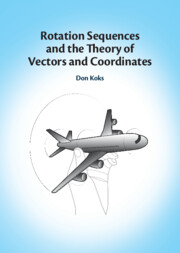Book contents
- Frontmatter
- Contents
- Preface
- 1 Setting the Scene
- 2 Trigonometry, the Foundation of Coordinate Theory
- 3 The Vector Dot and Cross Products
- 4 Vector Preliminaries and Constructing a Basis
- 5 Converting Vector Coordinates Across Bases
- 6 Vector Rotation in Two and Three Dimensions
- 7 Rotation Sequences and the Fundamental Theorem
- 8 Coordinate Systems for Earth, and More Rotation Sequences
- 9 The Role of Quaternions in Rotation Theory
- 10 Time Dependence of Vehicle Attitude
- 11 Frame Dependence of the Time Derivative
- 12 Earth’s Orientation in Space, and Time on Earth
- 13 Orbital Mechanics
- 14 Rigid-Body Dynamics
- 15 Modelling the Motion and Attitude of a Vehicle
- 16 Concepts of Tensor Analysis
- Index
7 - Rotation Sequences and the Fundamental Theorem
Published online by Cambridge University Press: 17 April 2025
- Frontmatter
- Contents
- Preface
- 1 Setting the Scene
- 2 Trigonometry, the Foundation of Coordinate Theory
- 3 The Vector Dot and Cross Products
- 4 Vector Preliminaries and Constructing a Basis
- 5 Converting Vector Coordinates Across Bases
- 6 Vector Rotation in Two and Three Dimensions
- 7 Rotation Sequences and the Fundamental Theorem
- 8 Coordinate Systems for Earth, and More Rotation Sequences
- 9 The Role of Quaternions in Rotation Theory
- 10 Time Dependence of Vehicle Attitude
- 11 Frame Dependence of the Time Derivative
- 12 Earth’s Orientation in Space, and Time on Earth
- 13 Orbital Mechanics
- 14 Rigid-Body Dynamics
- 15 Modelling the Motion and Attitude of a Vehicle
- 16 Concepts of Tensor Analysis
- Index
Summary
I introduce an important way to think about and construct a DCM: by implementing a yaw–pitch–roll sequence of rotations on a model aircraft. This does away with the widespread but rather involved method of describing the relative orientation of two axis sets by drawing them with a common origin. For this, we must distinguish the idea of a rotation in a sequence being about either a ‘space-fixed’ axis or a ‘carried-along’ axis. Users of these terms tend to fall into two groups, ‘active’ and ‘passive’. I state the ‘fundamental theorem of rotation sequences’, which does away with any need for the reader to stand in one group or the other. I also discuss the extraction of Euler angles from a DCM, and examine infinitesimal rotations. I discuss two methods of interpolating from an initial to a final orientation; one of these is used widely in computer graphics, but both methods must be discussed for the computer-graphics method to be understood. I end with a calculation of the position and attitude of a robot arm.
Keywords
- Type
- Chapter
- Information
- Rotation Sequences and the Theory of Vectors and Coordinates , pp. 171 - 220Publisher: Cambridge University PressPrint publication year: 2025

